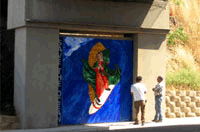On a recent Sunday morning I drove along Route 79 through the entire town of Temecula. What was even more astonishing than the fact that I saw less than ten pedestrians along over five miles of finely landscaped sidewalks was the fact that of those ten pedestrians only four were not displaying billboards on their bodies. Those six pedestrians, the majority of the people on one of the main streets of a thriving city, were sign-twirlers, also known as human directionals, or human signs. They were being paid to loiter, you could say, but because they were being paid, they weren’t really loitering. They were working. And this brings me to my first question: what ever happened to loitering?
If there were the salad days of loitering then they would have taken place in Paris in the mid-19th century. An influx of cheap foreign goods, the implementation of glass and steel as construction materials, lots of wine, and above all the invention of the world’s first covered shopping arcade (the prototype of the mall): these forces conspired, in Paris, to produce the flâneur, the loiterer par excellence. To get an idea of the pace of the flâneur (from the French word for “to stroll”), you only have to consider that, around 1840, it became fashionable in Paris to take one’s pet turtle for a walk. The flâneur delighted in strolling with his turtle through the covered shopping arcades (a lurker, he always favored the shadows), practicing physiognomy—the art of reading a person’s character from his or her face—collecting obscure objects, getting lost, patronizing prostitutes, going on spontaneous “missions,” falling in love—always at last sight—and in general, loitering. Not long after the development of the arcades, though, Baron Hausmann, the famous Paris civic engineer, “renovated” Paris by establishing a series of broadways throughout the labyrinthine city. Many of those broadways entailed the demolishment of the arcades, and in general made the life of the Parisian pedestrian much more dangerous.
The flâneur became an endangered species and loitering a crime. Flâneurs took refuge on the streets (they didn’t know anywhere else) by seeking employment as sandwich men—a new form of employment following the introduction of an act taxing all public advertisements—or prostitutes. At about that time the introduction of an act taxing all public advertisements created a loophole that the sandwich man filled.
Loitering was saved by being instituted as a form of employment. But it would not last for long. Many considered the sandwich man to be the last incarnation of the flâneur.
While passing through Temecula it occurred to me that the sign-twirler is a reincarnation of the sandwich man. But to be more specific, and more precise, the sign-twirler is the afterlife of the sandwich man: he (or she) is the flâneur in hell. The course (and demise) of public space can be seen in its trajectory from Parisian streets populated by turtle-walking dandies to Temecula’s empty streets devoid of pedestrians—save the odd sign-twirling adolescent. From the 19th to 21st centuries, public space has become one in which the pedestrian can appear only as a commercial, only as an advertisement. The intersection and crosswalk are no longer spaces of chance encounter and random human interaction, but yet another commercialized space.
My favorite sign-twirler is Matthew Collins. There is, or there used to be, a video of a news segment about him posted on his website (Ch. 5 San Francisco). In this video Matt could be seen twirling a sign for Mancini’s Sleepworld on a deserted San Jose street corner. “It’s the perfect anti-job,” says the Spinmaster, “I work outside listening to Metallica, Def Leppard, AC/DC and get to have fun with the cars as they go by.” I need, today the flâneur interacts only with cars; there aren’t any people around. In the entire news segment not a single other pedestrian is seen. The only other human can be seen off in the distance. It is another, less enthusiastic human sign slouching against a fire hydrant. There is no recognition by each of one another, let alone any solidarity, any mutual acknowledgment of the absurdity of existence. Suddenly the lack of benches –not that one could relax for a moment along this corridor of transportation and acceleration—becomes apparent too. Increasingly one has the feeling that the city is no longer a space capable of being inhabited. When, at one point in the news segment, the Spinmaster loses consciousness and collapses on his sign (bearing the words “Mancini’s Sleepworld), I can’t help but think that the human, or at least the pedestrian, collapses at that moment too. He will sleep uneasily on the street of broken dreams. There remain, however, signs of life in the Spinmaster—now and again you see erratic twitching and sudden convulsions: these may be the last paroxysms of life, or they may be the first trembling of a new uprising. We should do anything we can to provoke that fire, to coax those embers into the great conflagration they contain.








Viva la Creep!
I wonder how much you can make providing Human Directional Services.
There is this kick ass guy i see every morning up here in Santa Monica on Linclon Blvd. in front of a stereo store, and while i am wiping the crusties out of my eyes and driving in a cannabis induced morning haze, this guy is up and at em, enthusiastically spinning in either an elvis, captain america, or clown costume. He is well into his 50’s or 60’s, always has a HUGE stogie in his mouth and just plain KICKS ASS. VIVA LA CREEP INDEEEEEEED!!!!!!